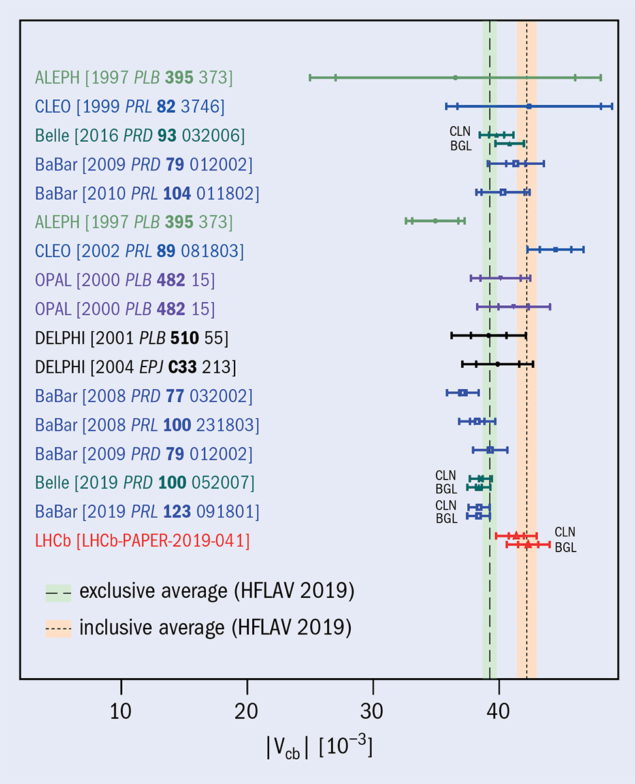A report from the LHCb experiment

There is a longstanding puzzle concerning the value of the Cabibbo–Kobayashi–Maskawa matrix element |Vcb|, which describes the coupling between charm and beauty quarks in W± interactions. This fundamental parameter of the Standard Model has been measured with two complementary methods. One uses the inclusive rate of b-hadron decays into final states containing a c hadron and a charged lepton; the other measures the rate of a specific (exclusive) semileptonic B decay, e.g. B0 → D*–μ+νμ. The world average of results using the inclusive approach, |Vcb|incl = (42.19 ± 0.78) × 10–3, differs from the average of results using the exclusive approach, |Vcb|excl = (39.25 ± 0.56) × 10–3, by approximately three standard deviations.
So far, exclusive determinations have been carried out only at e+e– colliders, using B0 and B+ decays. Operating at the ϒ(4S) resonance, the full decay kinematics can be determined, despite the undetected neutrino, and the total number of B mesons produced, needed to measure |Vcb|, is known precisely. The situation is more challenging in a hadron collider – but the LHCb collaboration has just completed an exclusive measurement of |Vcb| based, for the first time, on Bs0 decays.
The exclusive determination of |Vcb| relies on the description of strong-interaction effects for the b and c quarks bound in mesons, the so-called form factors (FF). These are functions of the recoil momentum of the c meson in the b-meson rest frame, and are calculated using non-perturbative QCD techniques, such as lattice QCD or QCD sum rules. A key advantage of semileptonic Bs0 decays, compared to B0/+ decays, is that their FF can be more precisely computed. Recently, the FF parametrisation used in the exclusive determination has been considered to be a possible origin of the inclusive–exclusive discrepancy, and comparisons between the results for |Vcb| obtained using different parametrisations, such as that by Caprini, Lellouch and Neubert (CLN) and that by Boyd, Grinstein and Lebed (BGL), are considered a key check.
Both parametrisations are employed by LHCb in a new analysis of Bs0 → Ds(*)–μ+νμ decays, using a novel method that does not require the momentum of particles other than Ds– and μ+ to be estimated. The analysis also uses B0 → D(*)–μ+νμ as a normalisation mode, which has the key advantage that many systematic effects cancel in the ratio. With the form factors and relative efficiency-corrected yields in hand, obtaining |Vcb| requires only a few more inputs: branching fractions that were well measured at the B-factories, and the ratio of Bs0 and B0 production fractions measured at LHCb.
The values of |Vcb| obtained are (41.4 ± 1.6) × 10–3 and (42.3 ± 1.7) × 10–3 in the CLN and BGL parametrisations, respectively. These results are compatible with each other and agree with previous measurements with exclusive decays, as well as the inclusive determination (figure 1). This new technique can also be applied to B0 decays, giving excellent prospects for new |Vcb| measurements at LHCb. They will also benefit from expected improvements at Belle II to a key external input, the B0 → D(*)–μ+νμ branching fraction. Belle II’s own measurement of |Vcb| is also expected to have reduced systematic uncertainties. In addition, new lattice QCD calculations for the full range of the D*– recoil momentum are expected soon and should give valuable constraints on the form factors. This synergy between theoretical advances, Belle II and LHCb (and its upgrade, due to start in 2021) will very likely say the final word on the |Vcb| puzzle.
Further reading
LHCb Collab. LHCb-PAPER-2019-041.







